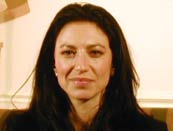 What was it like working with the puppets?
What was it like working with the puppets?
One of the strangest things I experienced on one of my first days on Farscape was being led by the hand into the creature shop to meet Pilot and Rygel. I can't remember if his skin was on. The skin is the latex exterior that gets placed over him and changed depending on what we inflict upon them - the artists re-paint the exterior. By season two or three they were getting so frequently slimed, or dealing with food, that they were being changed with regularity.
The work behind making those puppets come to life astounded me from pre-production through to being on set. On set it was a work-in-progress. The Jim Henson company spend a lot of money on R&D as they're going; they're constantly trying to refine the technology. The animatronics in Rygel cost millions of dollars, I think, over several years of working on other projects.
To finally create Rygel as a character, 4 to 5 people on the floor would help bring in John Eccleston. His arm would be in the puppet, inside Rygel, and he would articulate the body and head. There'd be people physically moving him in, and they would have these special glasses that had cameras inside them. They could see on the monitor what the directors were seeing so they could position the puppet into the right place. We would seldom do shots where Rygel was flying in where you could see below the sled, as that's a very expensive shot to do and time consuming for the computer generators - for the CGI group.
Then there would be someone separately doing Rygel's eyes - his mouth was animatronics, and his ears. The puppeteer would do his voice on set only to be re-voiced by Jonathan Hardy afterwards, so there was a weird adjustment period getting used to the fact that there was a different character on set than there was after it had been revoiced. Rygel was quite ebullient on set, and cheeky, and then by the time Jonathan Hardy's very gruff voice came in he was a lot older and wiser, so that took a while to adjust to.
Then there were also the green screen elements, that component: screaming at a monster that isn't really there. Sometimes there wasn't much information the directors could give us at any given time. What that does for an actor - the lesson I really learned - was to distil everything and to simplify it down so that the responses I'm giving were generic enough that they could be applied to whatever gets placed in afterwards. But [I was] also having to conjure something that is real from the inside, so that you're not hamming it too much.

